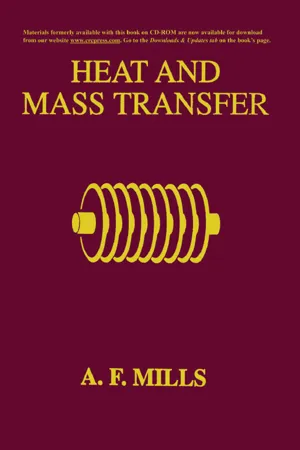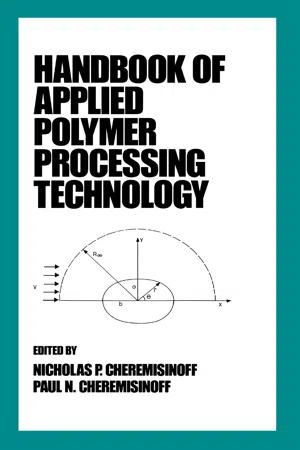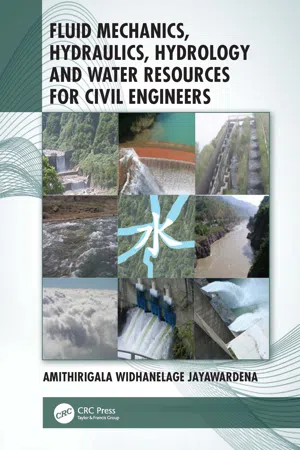Technology & Engineering
Couette Flow
Couette flow is a type of viscous fluid flow between two parallel plates, where one plate is stationary and the other is in constant motion. This flow is characterized by the shearing motion of the fluid, with the velocity of the fluid increasing linearly from the stationary plate to the moving plate. Couette flow is an important concept in fluid dynamics and has applications in various engineering and scientific fields.
Written by Perlego with AI-assistance
Related key terms
Related key terms
1 of 4
Related key terms
1 of 3
4 Key excerpts on "Couette Flow"
- eBook - ePub
- Ronald L. Panton(Author)
- 2024(Publication Date)
- Wiley(Publisher)
Actually the Taylor–Couette pattern is not always stable and many more complex patterns, discussed in Section, have been found. 7.4 PRESSURE-DRIVEN FLOW IN A SLOT WITH A MOVING WALL In the problems we analyzed in Sections 7.1 and 7.3, the velocity was governed by linear differential equations and linear boundary conditions. In this section we study a composite flow. Let the Poiseuille flow velocity be and the Couette Flow velocity be then the algebraic sum represents the flow in a slot with a moving wall and an imposed pressure gradient, both acting simultaneously: or in a slightly different form, In this equation is a nondimensional parameter that indicates the relative effects of the pressure gradient and the wall motion. The parameter is given by Velocity profiles are shown in Fig. 7.6. We shall find that these velocity profiles are good local approximations to the flow in slider bearings or any other plane lubrication flow. The value of changes with location in the bearing. Figure 7.6 Velocity profiles for combined Couette–Poiseuille flow. The pressure-gradient parameter is. 7.5 DOUBLE FALLING FILM ON A WALL The double falling film is a problem designed to illustrate the boundary conditions between two immiscible liquids and the boundary condition between gases and liquids. Consider the flow situation depicted in Fig. 7.7, where a smooth plane is inclined at an angle to the vertical. Two immiscible liquid films flow down the plane under the influence of gravity. The actual thickness of each film is controlled by the method by which the flow is established. We do not concern ourselves with how the flow is established or how long it takes to reach a steady profile independent of. These problems are avoided by assuming that the film thicknesses and have known values. Figure 7.7 Films of two immiscible fluids falling down an inclined wall. We take a rectangular coordinate system aligned with the flow and having the -axis on the plate - eBook - ePub
- Anthony Mills(Author)
- 2018(Publication Date)
- CRC Press(Publisher)
For laminar flows, the basic physics is simple, involving only conservation principles, Newton’s law of viscosity, and Fourier’s law of heat conduction. However, the flows of engineering concern are more often turbulent. Understanding the nature of turbulent flows remains one of the unsolved problems of physics. Only recently, with the aid of supercomputers, has there been significant progress at a basic level. Thus, out of necessity, engineers have relied on simple empirical models to describe turbulent transport of momentum and energy. Development of these models has relied heavily on experimental data, in particular, measured velocity and temperature profiles. An appreciation of the pertinent experimental data is essential. What engineers call turbulent flow theory is a partial theory only; but in science and engineering, it is possibly unique in its careful blending of theory and empiricism.The difficulties just described dictate the organization of Chapter 5 . In Sections 5.2 and 5.3 , two simple analytical solutions are presented. In both cases, the governing equations are derived from first principles. The analysis of high-speed Couette Flow in Section 5.2 leads to the recovery factor concept, which allows generalization of the flat plate heat transfer correlations in Chapter 4 to include high-speed flow. In Section 5.4 , the equations governing a forced-convection laminar boundary layer on a flat plate are derived, again from first principles. An exact analytical solution is obtained for the limit of zero Prandtl number, which is useful for liquid metals. The integral method is used to obtain approximate analytical solutions for both forced- and natural-convection boundary layers. The forced-convection laminar boundary layer is also solved exactly as a self-similar flow, for which the mathematics involved are more demanding.Sections 5.2 through 5.4 can be regarded as an introduction to convection analysis. The remaining sections contain more advanced material. Turbulent flow is dealt with in Section 5.5 . Empirical turbulent transport models are developed and are then used for the analysis of a turbulent boundary layer on a flat plate and of turbulent flow in a tube. Section 5.6 introduces the concepts of similarity and modeling for convection, using the flows analyzed in Sections 5.2 through 5.4 as examples. The general conservation equations governing mass, momentum, and energy are presented in Section 5.7 . Cartesian coordinates are used, but the results are also written in vector form for conciseness and generality. Finally, in Section 5.8 , the methods of scale analysis - Nicholas P. Cheremisinoff, Paul N. Cheremisinoff(Authors)
- 2020(Publication Date)
- CRC Press(Publisher)
The basic annular flow models are discussed first, and then applied to situations of practical importance. As a matter of useful terminology, flows solely due to an imposed pressure gradient are referred to as Poiseuille flows (or pressure flows), whereas flows solely due to a bounding surface in motion are referred to as Couette Flows (or drag flows). Flows with an imposed pressure gradient as well as moving bounding surface(s) are termed generalized Couette Flows (or combined pressure and drag flows).A. Axial Generalized Couette Flow
The axial generalized Couette Flow problem in an annulus for a power-law fluid has been investigated by Lin and Hsu [1 ]. However, their solution is not complete because the possibility of the pressure gradient opposing the drag flow is not considered. Furthermore, their volumetric flow-rate expressions are in the form of definite integrals necessitating numerical quadrature. Malik and Shenoy [2 ] have presented the complete solution and evaluated the flow integrals analytically. However, their derivation involves two separate cases, one in which there is a maximum or minimum in the velocity profile within the annular region and another in which there is not. In what follows, a single exact analytical expression for the volumetric flow rate is derived that holds for both cases and has a simple algebraic form useful in performing quick practical calculations.Malik and Shenoy [2 ] considered a power-law fluid between two long coaxial cylinders of length L (Fig. 1 ), with the outer cylinder (r = R) being stationary and the inner cylinder (r = kR) moving at a constant axial velocity V in the positive z-direction. Furthermore, there was a constant pressure gradient (ΔP/L) in the z-direction. For this one-dimensional flow problem, the equation of motion in cylindrical coordinates simplifies to=d(r)τr zd r(r)Δ PL(1) If ξ denotes r/R- Amithirigala Widhanelage Jayawardena(Author)
- 2021(Publication Date)
- CRC Press(Publisher)
velocity V is given. as V = Q A = h 2 3 μ (− d p d x) (7.78) S h e a r s t r e s s τ x y = μ d u d y = μ h 2 2 μ (− d p d x) (− 2 y h 2) (7.79) W a l l s h e a r s t r e s s (τ 0) y = h = μ[-. -=PLGO-SEPARATOR=--]h (− d p d x) (7.80a) (τ 0) y = − h = − μ h (− d p d x) (7.80b) When one plate is fixed and the other one is moving at a constant velocity, the resulting flow is known as Couette Flow. The governing equations in this case can be written as follows: u = u (y) ; v = 0 The momentum equations as before in the x and y directions, respectively, are 0 = − d p d x + μ d 2 u d y 2 0 = − d p d y When the momentum equation is integrated subject to the boundary conditions u = u 0 when y = h, and u = 0 when y = 0, where h is the distance of separation of the two plates, the result. is u u 0 = y h + (− d p d x) (h 2 2 μ u 0) (y h) (1 − y h) (7.81) Using a dimensionless pressure gradient C and a dimensionless distance between the plates defined as C = (− d p d x) (h 2 2 μ u 0) a n d Y = y h (7.82) Equation 7.81 can be written. as u u 0 = y h + C (y h − (y h) 2) = Y + C (Y − Y 2), o r u u 0 = (1 + C) Y − C Y 2 (7.83) Equation 7.83 can be considered under different dimensionless pressure gradients. When d p d x = 0 o r C = 0, the velocity becomes u u 0 = y h (linear velocity profile). This condition is also known as simple Couette Flow. When d p d x > 0 o r C < 0, using a nominal value of −1 for C, the velocity becomes u u 0 = Y 2, which is a quadratic velocity profile. In this case, the pressure increases with increasing distance resulting in a decrease in velocity. Flow separation can take place when the pressure gradient is positive. When d p d x < 0 o r C > 0, using a nominal value of +1 for C, the velocity becomes u u 0 = 2 Y − Y 2. In this case, the pressure decreases with distance resulting in an increase in velocity. The average velocity is given as V = ∫ [ u 0 y h + C u 0 (y h − y 2 h 2) d (y h) ] = (1 2 + C 6) u 0 (7.84) For simple Couette Flow, Eq
Index pages curate the most relevant extracts from our library of academic textbooks. They’ve been created using an in-house natural language model (NLM), each adding context and meaning to key research topics.
Explore more topic indexes
Explore more topic indexes
1 of 6
Explore more topic indexes
1 of 4



